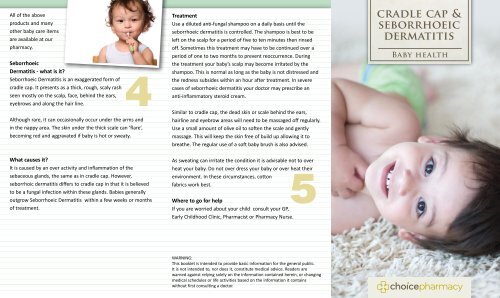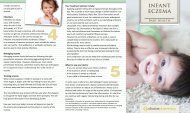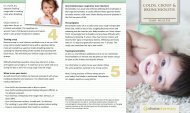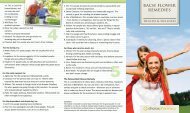cradle cap & seborrhoeic dermatitis - Choice Pharmacy
cradle cap & seborrhoeic dermatitis - Choice Pharmacy
cradle cap & seborrhoeic dermatitis - Choice Pharmacy
Create successful ePaper yourself
Turn your PDF publications into a flip-book with our unique Google optimized e-Paper software.
All of the above<br />
products and many<br />
other baby care items<br />
are available at our<br />
pharmacy.<br />
Seborrhoeic<br />
Dermatitis - what is it?<br />
Seborrhoeic Dermatitis is an exaggerated form of<br />
<strong>cradle</strong> <strong>cap</strong>. It presents as a thick, rough, scaly rash<br />
seen mostly on the scalp, face, behind the ears,<br />
eyebrows and along the hair line.<br />
Although rare, it can occasionally occur under the arms and<br />
in the nappy area. The skin under the thick scale can ‘flare’,<br />
becoming red and aggravated if baby is hot or sweaty.<br />
Treatment<br />
Use a diluted anti-fungal shampoo on a daily basis until the<br />
<strong>seborrhoeic</strong> <strong>dermatitis</strong> is controlled. The shampoo is best to be<br />
left on the scalp for a period of five to ten minutes then rinsed<br />
off. Sometimes this treatment may have to be continued over a<br />
period of one to two months to prevent reoccurrence. During<br />
the treatment your baby’s scalp may become irritated by the<br />
shampoo. This is normal as long as the baby is not distressed and<br />
the redness subsides within an hour after treatment. In severe<br />
cases of <strong>seborrhoeic</strong> <strong>dermatitis</strong> your doctor may prescribe an<br />
anti-inflammatory steroid cream.<br />
Similar to <strong>cradle</strong> <strong>cap</strong>, the dead skin or scale behind the ears,<br />
hairline and eyebrow areas will need to be massaged off regularly.<br />
Use a small amount of olive oil to soften the scale and gently<br />
massage. This will keep the skin free of build up allowing it to<br />
breathe. The regular use of a soft baby brush is also advised.<br />
<strong>cradle</strong> <strong>cap</strong> &<br />
<strong>seborrhoeic</strong><br />
<strong>dermatitis</strong><br />
Baby health<br />
What causes it?<br />
It is caused by an over activity and inflammation of the<br />
sebaceous glands, the same as in <strong>cradle</strong> <strong>cap</strong>. However,<br />
seborrhoic <strong>dermatitis</strong> differs to <strong>cradle</strong> <strong>cap</strong> in that it is believed<br />
to be a fungal infection within these glands. Babies generally<br />
outgrow Seborrhoeic Dermatitis within a few weeks or months<br />
of treatment.<br />
As sweating can irritate the condition it is advisable not to over<br />
heat your baby. Do not over dress your baby or over heat their<br />
environment. In these circumstances, cotton<br />
fabrics work best.<br />
Where to go for help<br />
If you are worried about your child consult your GP,<br />
Early Childhood Clinic, Pharmacist or <strong>Pharmacy</strong> Nurse.<br />
WARNING:<br />
This booklet is intended to provide basic information for the general public.<br />
It is not intended to, nor does it, constitute medical advice. Readers are<br />
warned against relying solely on the information contained herein, or changing<br />
medical schedules or life activities based on the information it contains<br />
without first consulting a doctor.
Cradle <strong>cap</strong> is a very common problem affecting babies<br />
from around 4-6 weeks of age. It often reoccurs throughout<br />
childhood, affecting children up to the age of 3-5 years old.<br />
Cradle <strong>cap</strong> is a<br />
very common<br />
problem<br />
affecting<br />
infants from<br />
around 4-6<br />
weeks of age.<br />
What is it?<br />
Cradle <strong>cap</strong> first appears as small yellow<br />
patches or dry flaky skin on a young<br />
infant’s scalp. It usually occurs on the top<br />
of the scalp over the front fontanelle<br />
(the soft spot on top of a baby’s head),<br />
but it can quickly spread over the entire<br />
head if untreated.<br />
What causes it?<br />
Cradle <strong>cap</strong> is caused by over activity of the sebaceous (oilproducing)<br />
glands on the baby’s scalp. If the scalp is not<br />
massaged or stimulated, this over-activity leads to a build<br />
up of natural oils and dry dead skin cells that form scales. A<br />
thick yellow-brown crust on the baby’s head results and the<br />
skin beneath the crusts can become red and inflamed and<br />
prone to infection. It is not a form of dandruff and does not<br />
indicate poor hygiene or lack of care. If <strong>cradle</strong> <strong>cap</strong> becomes<br />
thick and widespread, it can become quite smelly. This is<br />
due to dead skin and oil build up.<br />
Treatment<br />
Treatment is simple<br />
and can be done in<br />
one of the following<br />
ways:<br />
1.Apply Wild Child Cradle Cap Oil or<br />
Pure Olive Oil to the scalp by saturating a cotton wool ball with<br />
the oil and thoroughly massaging in. Reapply oil at each nappy<br />
change and leave on for 24 hours then wash off using a gentle,<br />
mild shampoo such as AromaBaby, Sebamed or Dermaveen<br />
Shampoo.<br />
2.Apply Calendula Cream to scalp during each nappy change,<br />
massaging the scalp when applying and leave on for 24 hours<br />
then shampoo off using a gentle shampoo as mentioned<br />
previously.<br />
3.Apply Ego Zite Cradle Cap Lotion twice a day for 3-5 days<br />
without washing the hair, then shampoo off using a gentle<br />
shampoo as above.<br />
All treatments will loosen and lift the dead skin and/or crusts. You<br />
will then need to massage the scalp vigorously to encourage the<br />
<strong>cradle</strong> <strong>cap</strong> to be rubbed off. Treatments may have to be repeated<br />
several times, depending on the amount of <strong>cradle</strong> <strong>cap</strong> present.<br />
Do not be tempted to pick off the crusts yourself as this may hurt<br />
your baby and could also lead to infection of the inflamed skin<br />
underneath the scales.<br />
Prevention of reoccurrences<br />
When the problem has cleared up, it is a very good idea to<br />
massage baby’s scalp regularly using a soft baby flannel, brush<br />
or your hands. This stimulates baby’s scalp and helps prevent<br />
further <strong>cradle</strong> <strong>cap</strong> from reappearing.<br />
Don’t be frightened of massaging the fontanelle areas on baby’s<br />
scalp. The skin over these spots is tough and strong and cannot<br />
be easily damaged with normal handling.<br />
Avoid perfumed shampoos and soaps and only shampoo the<br />
scalp once or no more than twice a week. It’s also a good idea<br />
to avoid wetting the scalp in the bath each night.<br />
All of these factors can disrupt the delicate pH<br />
(a term used to describe acidity or alkalinity) of<br />
the skin and wash away essential oils, inflaming<br />
the condition further.<br />
If any small areas of <strong>cradle</strong> <strong>cap</strong> reappear, repeat above<br />
treatment when necessary.<br />
Helpful hint<br />
Pre-mix shampoo with a cup of warm water before applying it<br />
to baby’s scalp. This prevents the sensation of cold, causes less<br />
distress and means your baby is more likely to enjoy<br />
head-washing time. You can also pre-warm the wild child oil,<br />
olive oil or egozite solution by standing it in a jug of warm water<br />
for 5-10 minutes before applying it.





